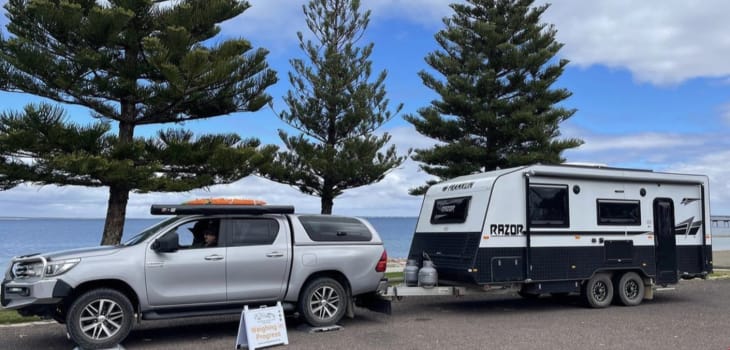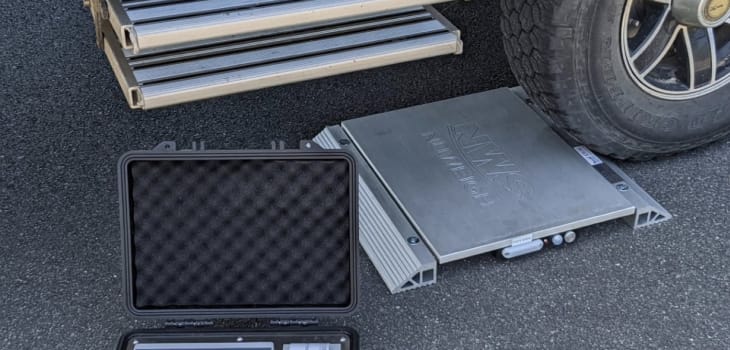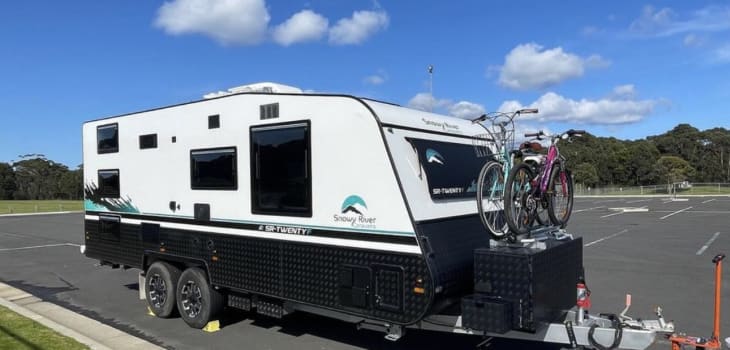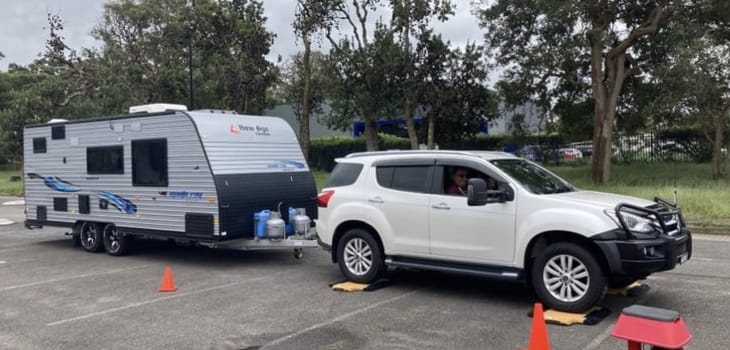A Beginner’s Guide to Caravan Weights
December 15, 2022

Photo credit @auswide.weighing
We see them everywhere, and they’ve been one of the most popular methods of camping ever since Scottish Medic Dr. William Stables commissioned the very first touring caravan back in 1855. But how much do we really know about what’s involved in towing a caravan?
Buying a caravan isn’t as simple as just heading down to the forecourt and picking one that looks good. Of course, that might be a big part of your initial attraction to your new tiny home, but you also need to know how much a caravan weighs before you hook it up to your car and drive away.
Making sure your tow vehicle is powerful enough and indeed the correct weight to pull your caravan is crucial if your first outing with your campervan, and indeed every other outing after that, is going to be a safe one.
But where and how do you figure out how much your caravan weighs, and how do you determine your kerb weight from your towing weight?
Over the course of this article, you’ll discover what some of the key caravan weighing terms mean as well as some handy tips and tricks when it comes to keeping your caravan at your optimum towing weight.

Photo credit @mobileweightcheck
How Much Does a Caravan Weigh?
As you might imagine, there’s no ‘one-size-fits-all’ when it comes to weighing a caravan. Still, there’s a general rule of thumb that you can follow to get an idea of the overall process. Think of it as ‘Caravan Weighing for Beginners’, and then we’ll get onto the nitty-gritty of the why and how in a second.
Essentially, the smaller caravans you see on the roads that can sleep two to four people will weigh somewhere between 800kg and 1300kg. That’s for your typical caravan, but there are lots of tiny trailers that come in under that weight. The Timberleaf Pika weighs in at 450kg, while the Earth Traveller weighs in at an incredible 298kgand is made from a special composite created from chicken feathers and resin!
Yes, you read that right!
Larger caravans that you tend to see families in advertise enough room for four to six people and can weigh up to 2,000kg.
If you’re opting for one of those, then you don’t want to be trying to tow it away with a Mini Cooper or a two-seater Smart Car.
But how do you go about weighing a caravan to see if you can tow it? And, more importantly, how do you find out whether it’s under the legal weight limit once you set off on your adventures?

Photo credit @auswide.weighing
Caravan Weights Explained
Are you sitting down? Good, because it’s time to learn some caravan weighing terms. After all, if you want to play the game properly, then you’ve got to know the lingo.
Let’s start off with the basics.
Before you start filling up water tanks or putting your cereal in the cupboards, you’ll need to know your car’s kerb weight.
The kerb weight is essentially the weight of the car as it comes off the production line before you add all your old wellington boots and dogs into the back of it. Once you know your kerb weight, the general guideline for how much you can tow with said car is 85% or less of the kerb weight.
Let’s get back to the caravan now, shall we? The next term I want to talk about is the MiRO. That stands for Mass in Running Order and is the term used for the average measurement of the caravan without any load. Think of it as the kerb weight of the caravan, the minimum weight of the caravan without any of your possessions in it. Then, there’s the MTPLM. We know it sounds like a secret government code, but it’s actually the term for how much you can actively carry in your caravan, the Maximum Technically Permissible Laden Mass. The maximum weight that you can tow with your driver’s license will depend on which license you currently have and if you have completed any extra towing tests or courses. For example, a standard UK driver’s license only allows you to tow a caravan or trailer of up to 3,500kg MAM. MAM is the Maximum Authorised Mass, sometimes known as the Gross Vehicle Weight or (you guessed it) GVW. The caravanning world really likes abbreviations, doesn’t it?!
How To Determine How Much Your Caravan Weighs
As the pictures in this article show, there are ways to have your car and caravan weighed professionally so that you know exactly how much weight you are dealing with without adding together every single item you place into your caravan. Caravan weighing companies will weigh your caravan either at a fixed facility or using a mobile system to determine the total weight of your trailer. You can also roll over a public weighbridge such as the one you might find down at the local tip or recycling centre to find out how much your caravan weighs. If you happen to come in under the legal towing limit after accounting for water, diesel and all your belongings — great! You have plenty of room for a few souvenirs.
What Size Caravan Can I Tow With My Car?
This very much all depends on how big your car is and what type of license you hold. Again, as we don’t know what size car you have or how big your caravan or trailer is, all we can do is give you a general rule of thumb.
It would be safe to assume that the bigger the car, the bigger the engine. That in turn means the bigger the engine, the larger the load you can pull, as long as your license dictates that you can legally tow said weight.
For example, a Fiat 500 can tow up to 800kg with trailer brakes, whereas a Chevy Silverado 3500HD can tow up to a whopping 16,300kg.
You definitely wouldn’t want a Fiat 500 to tow the Ford Earthroamer out of a ditch; go get the Chevy every time!

Photo credit @checkweightcaravanweighing
Tips For Cargo & Keeping Your Caravan Lightweight
You don’t need a degree in rocket science to know that the more you add into your caravan, the heavier it’s going to be. The heavier your tow vehicle, the more fuel you will use up, too, so don’t go too wild on the ‘everything including the kitchen sink’ way of thinking! Minimalism is key in the caravan towing world.
If you want to keep your caravan as light as possible while travelling around, then there are some simple tips and tricks you can follow to make sure that you stay under the legal weight limit and keep those fuel costs down.
For starters, place some of the heavier items inside your towing vehicle, or at least distribute the weight evenly so you don’t have all the heavy items in your caravan. That goes for leisure batteries, too; those things are heavy, so if you’re determined to bring all your pairs of shoes and a whole library of books, then take a leisure battery out and place it in the car.
Water weighs a lot, and unless you’re camping off grid, you don’t need to be travelling with a full tank of it. Make sure that your water tanks, that’s fresh, black and grey, are all empty before you travel.
Lastly, only bring what you need with you. If you need to bring a gas burner, then bring the lightest model you can find and not a humongous gas barbecue. Likewise, if you don’t need a paddleboard for the journey you’re going on, then leave it at home. Only bring what you need for the adventure at hand and keep your tow weight to a minimum.

Photo credit @kampvekaravangunlugu
If you’re new to the caravanning world and want more tips and tricks, then check out Lippert’s articles on a beginner’s guide to caravan electric hookup and the basics of towing a caravan!
About the Author

Lippert guest blogger, Sebastian Antonio Santabarbara, is a thirty-two-year-old writer from Yorkshire, UK. His first breakthrough role came as the Head of Written Content for Van Clan, an online media brand documenting the van life movement with a weekly reach of over 5 million readers. This role has led to Sebastian being head-hunted to write several inspirational non-fiction books on alternative living (to be published by Frances Lincoln 2022/23) and Van Life for Dummies (published by John Wiley & Sons Sept 2022). He is also the Editor in Chief for Retro Dodo, a media/news company with a monthly reach of 1 million people. Follow his travels on Instagram!
Recent Posts
7 Best Countries for Wild CampingTop Tips for Self Van Builders
5 Best Camper Van Batteries
Common Van Life Problems and How to Combat Them
How Much Does Vanlife Cost
How to Save Space by Choosing the Right Campervan Bed Insights From Vanpuravida
5 Easy Van Life Recipes
Is Vanlife Legal?
Expert Tips for Cleaning a Campervan
Things You Need to Know When Living in a Camper
View All ›
Never miss a blog post!
Subscribe to Lippert’s blog and receive an email when a new one is posted.